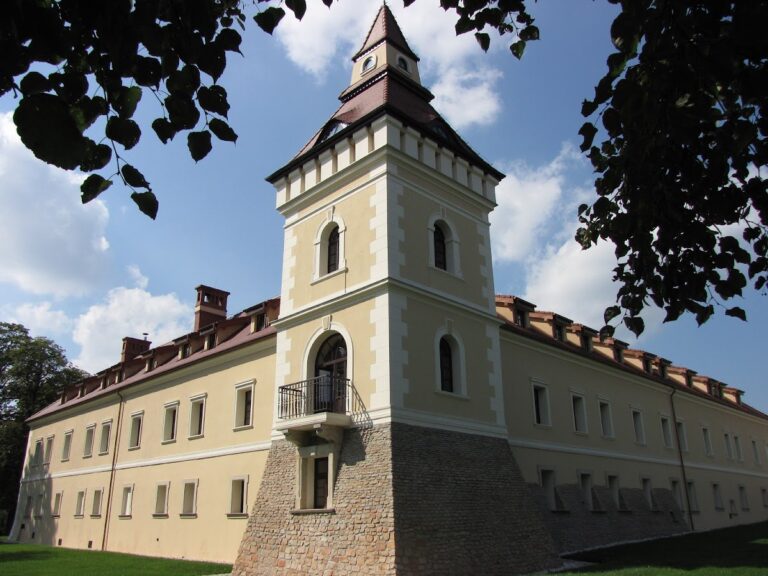Zamek w Koziegłowach: A Medieval Castle in Poland
Visitor Information
Google Rating: 4.2
Popularity: Very Low
Google Maps: View on Google Maps
Official Website: www.kozieglowy.pl
Country: Poland
Civilization: Unclassified
Remains: Military
History
Zamek w Koziegłowach is located in the municipality of Koziegłowy in modern Poland. This site was developed during the late Middle Ages by the Polish civilization, serving both defensive and administrative purposes in a border region frequently exposed to raids.
The earliest stone castle on the location was built in the late 14th century, replacing an older wooden fortification. It is believed to have been constructed either by Mściwoj of Kwilina, who lived between 1336 and 1385, or by Krystyn (I) of Koziegłowy, who held the position of castellan of Sącz and bore the Lis coat of arms. The castle’s military significance was recorded in 1409 by the chronicler Jan Długosz, who mentioned that Krystyn received troops from King Władysław Jagiełło to help safeguard the vulnerable border near the Silesian duchies. Notably, King Władysław Jagiełło himself stayed at the castle in 1426.
During the mid-15th century, specifically between 1452 and 1457, the castle faced multiple attacks by local nobles and bandits. These included Janek of Wołczyn, Dukes Przemek of Toszek and Jan IV of Oświęcim, as well as the outlaws Kawka and Świeborowski. By 1470, ownership had passed to Jan Koziegłowski, who in 1472 mandated that the town’s inhabitants maintain the castle’s defenses. This order involved tasks such as clearing ice from the surrounding moats and repairing wooden palisades, with carpenters compensated by the lord for their work.
In 1519, the castle and its estates were sold to Jan Konarski, the bishop of Kraków, bringing the property under ecclesiastical control. Over time, its strategic importance diminished, and by 1548 Bishop Samuel Maciejowski reported that the castle had been left unused and allowed the locals to pay a monetary tax instead of maintaining its fortifications. By the end of the 16th century, specifically in 1598, the castle was described as already in a state of ruin.
Despite its dilapidation, the castle’s remains played a role during the Swedish invasion of Poland in 1655. For several days, Stanisław Kawecki, holding the offices of burgrave and starost, used the ruins as a defensive stronghold. Centuries later, in 1865, the remaining structures were intentionally demolished by Russian authorities who repurposed the building materials to construct a road leading to nearby Gniazdów.
Archaeological investigations began in the 20th century, with initial excavations carried out from 1962 to 1969 by Dr. Włodzimierz Błaszczyk. These digs uncovered medieval coins, crossbow bolt heads, spurs, and cannonballs, primarily within the gate tower area. Further work in 2022 under Dr. Artur Ginter revealed parts of the eastern side of the castle, including the foundations of the gate tower and sections of the curtain wall. These discoveries also confirmed that demolition in the 19th century had only removed structures down to the ground level and highlighted that the gate tower was constructed after the curtain walls in separate phases.
Recently, a restoration project was initiated in December 2024, supported by a government program dedicated to monument reconstruction. This work aims to partially rebuild the castle, including its defensive walls, entrance gate, a wooden bridge, and palisades that once protected the site.
Remains
The archaeological remains of Zamek w Koziegłowach reveal a rectangular medieval castle measuring approximately 50 by 25 meters. It was surrounded by thick defensive walls about 2.5 meters wide, enclosing a central residential building. The eastern curtain wall featured a prominent gate tower, square in shape and measuring roughly 9 by 9 meters, with substantial walls reaching up to 2.4 meters in thickness. Access to the castle was provided by a causeway stretching 125 meters, crossing over the water-filled moat that enclosed the entire complex.
This moat was further defended by two embankments, each around 3 meters high and faced with limestone, adding strength and durability to the earthworks. Between the walls, the courtyard space was paved, distinguishing the interior area and possibly facilitating movement and drainage. Surrounding the main enclosure was an outer bailey, known locally as a podgrodzie, covering close to 800 square meters and likely serving as an additional protective and functional zone.
Today, only the foundational remains and the outlines of the moat survive at the site, preserving the castle’s original footprint. Excavations within the gate tower area uncovered artifacts including medieval coins, crossbow bolt heads indicative of the castle’s military use, spurs, and multiple cannonballs demonstrating periods of conflict and defense.
19th-century demolition efforts by Russian authorities removed above-ground parts of the castle, but archaeological work has shown much of the original masonry remains below the surface, allowing for ongoing study and restoration. The evidence that the gate tower was constructed in a later building phase than the curtain walls adds valuable insight into the castle’s development and architectural evolution over time.







